What just happened? As expected, AMD CEO Dr. Lisa Su took to the CES stage to kickstart the year with new hardware. While the announcements touch on a few different segments including console gaming hardware, industry collaborations and partnerships, and server bound Epyc chips, the main star of the show is the Ryzen Mobile 5000 line-up, bringing Zen 3 to laptop form factors.
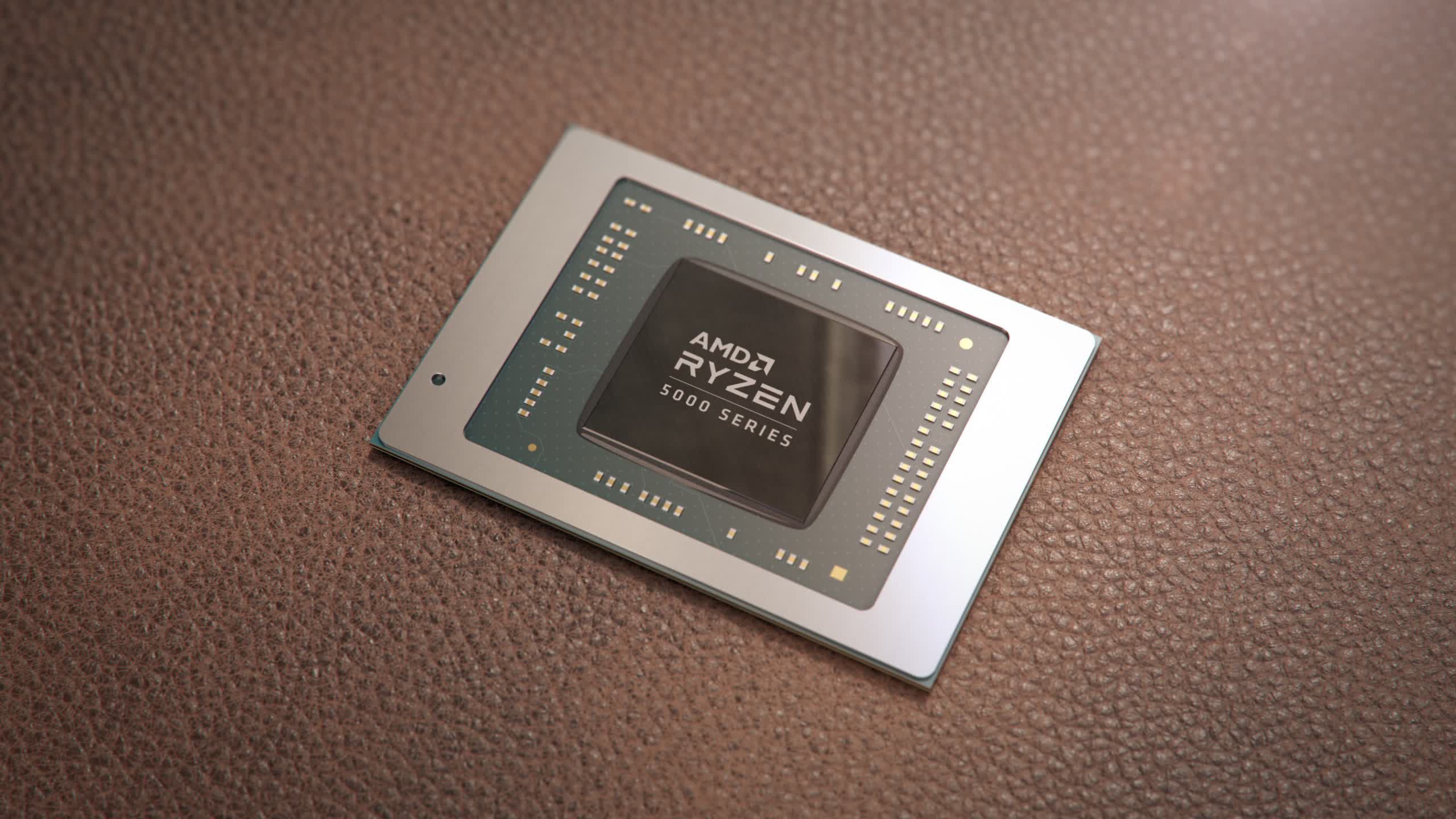
About a year after the announcement of Ryzen Mobile 4000, AMD is keeping up an impressive cadence for releasing new mobile parts. AMD are now quite competitive in this market and today we saw the announcement of a full stack of Ryzen Mobile 5000 products, including H-series for performance notebooks and gaming, and U-series parts for ultraportables.
The first and most important thing to note is that the Ryzen Mobile 5000 series includes parts from two separate lines: Cezanne, which feature Zen 3 CPU cores, and Lucienne, which still use Zen 2 CPU cores. While the majority of AMD’s new SKUs are Cezanne and based on Zen 3, the remaining parts are basically just a refresh of Ryzen Mobile 4000 "Renoir" CPUs with a few small improvements.
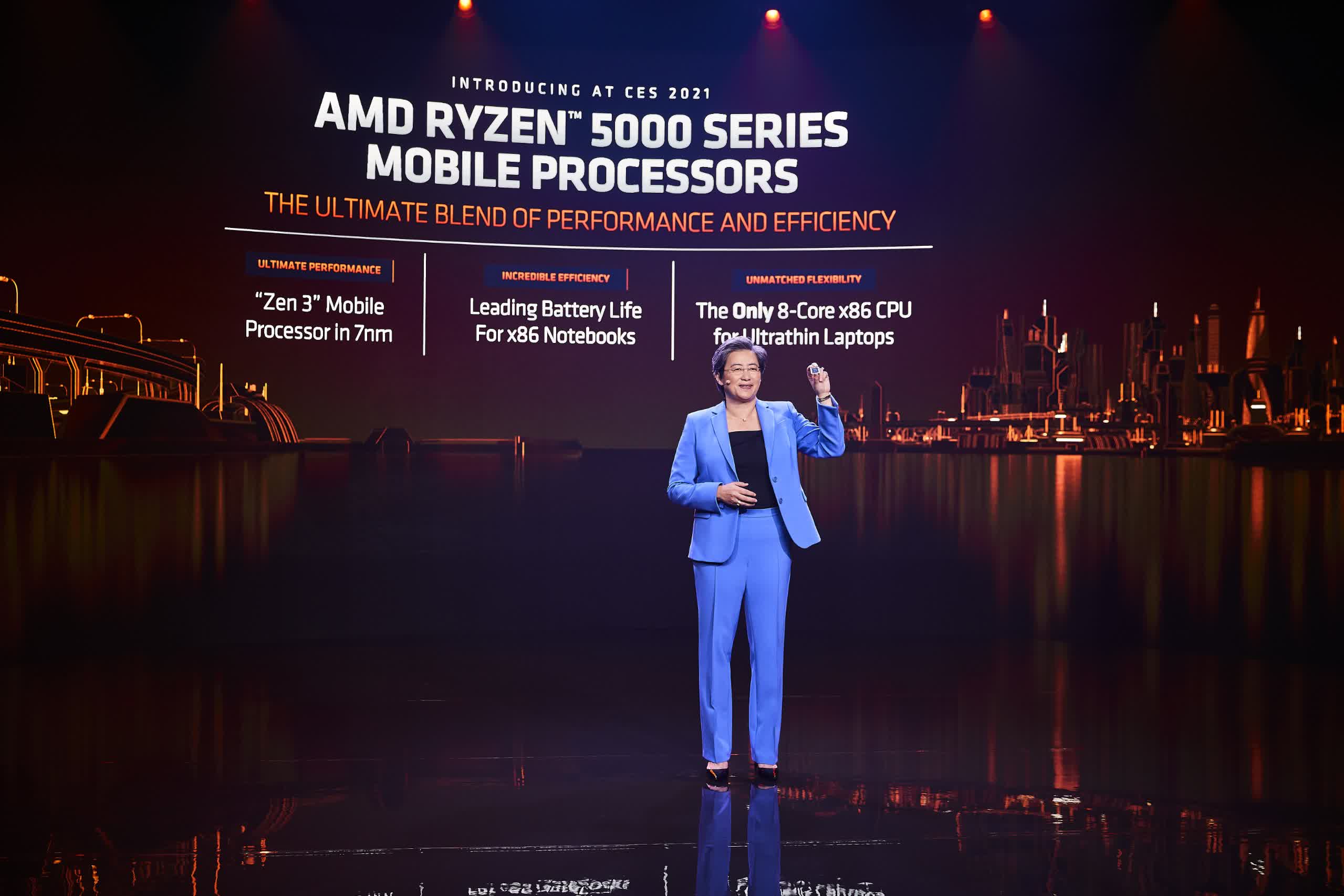
You can see in this chart that all AMD’s H-series are Zen 3, while there are just two U-series SKUs that use Zen 3: the Ryzen 7 5800U and Ryzen 5 5600U; the other three SKUs with an odd number in the second digit are Lucienne.
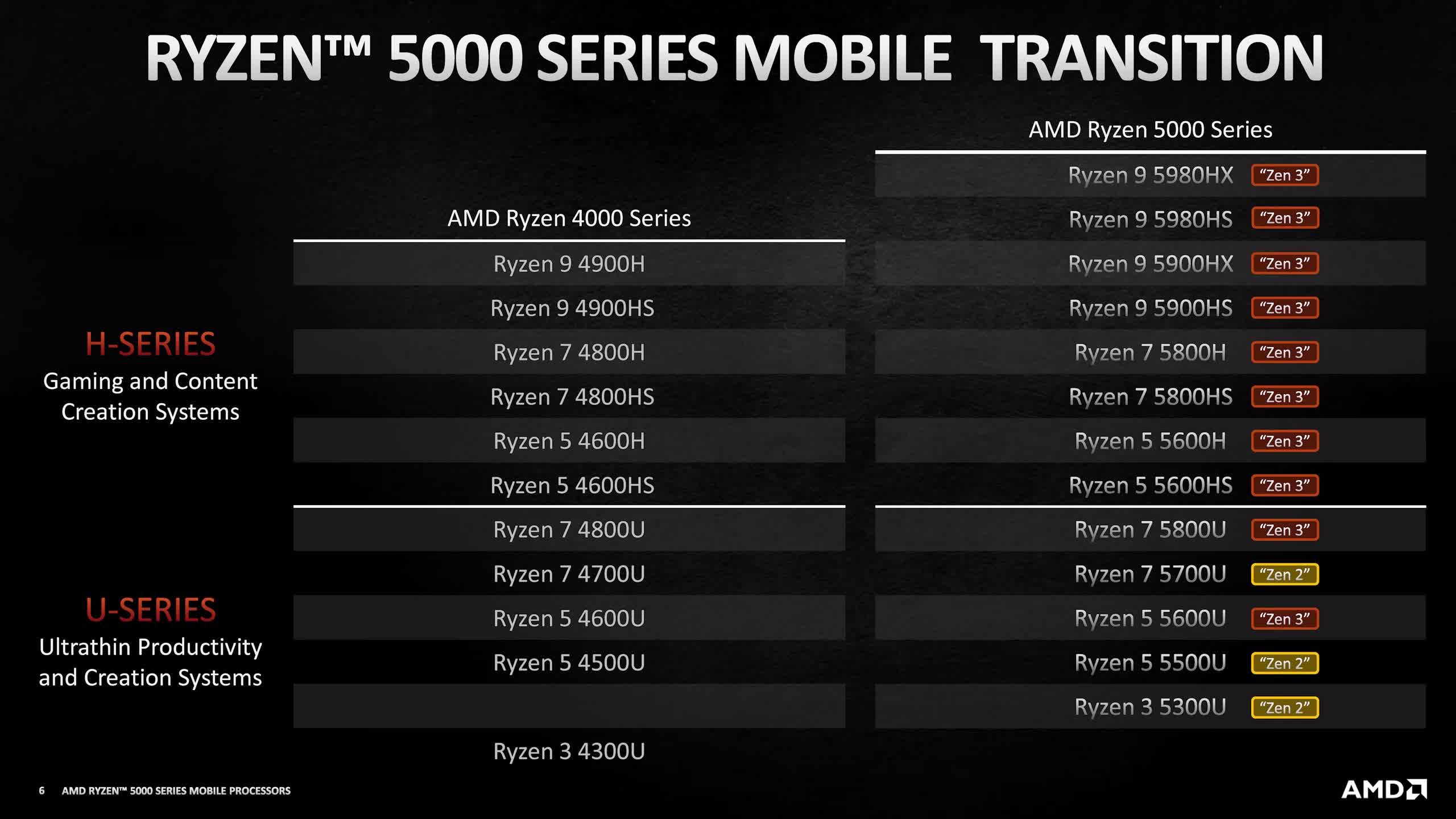
Let’s start by taking a closer look at the U-series, beginning with the Ryzen 7 5800U. This is a 15W beast, bringing 8 Zen 3 CPU cores and 16 threads. This is the same core/thread configuration as the Ryzen 7 4800U, and that’s to be expected and is already class leading given Intel’s equivalent parts top out at just four cores.
With the increased IPC made available through AMD’s Zen 3 architecture, we should be seeing an improvement of around 19% from the 5800U versus 4800U at the same frequency. AMD is also slightly increasing clock speeds: the base clock rises from 1.8 to 1.9 GHz, and the boost clock lifts from 4.2 GHz to 4.4 GHz. In addition, AMD has doubled the L3 cache, moving from 8MB with Renoir, to 16MB with Cezanne, for all products.
This is important, as the 8MB L3 was a little small with Ryzen 4000 CPUs and did cause a bottleneck in some applications. Moving to 16MB instead is significant and gives Ryzen 5000 Zen 3 processors more cache than Intel’s Tiger Lake U series chips, although Tiger Lake still has an advantage in cache per core.
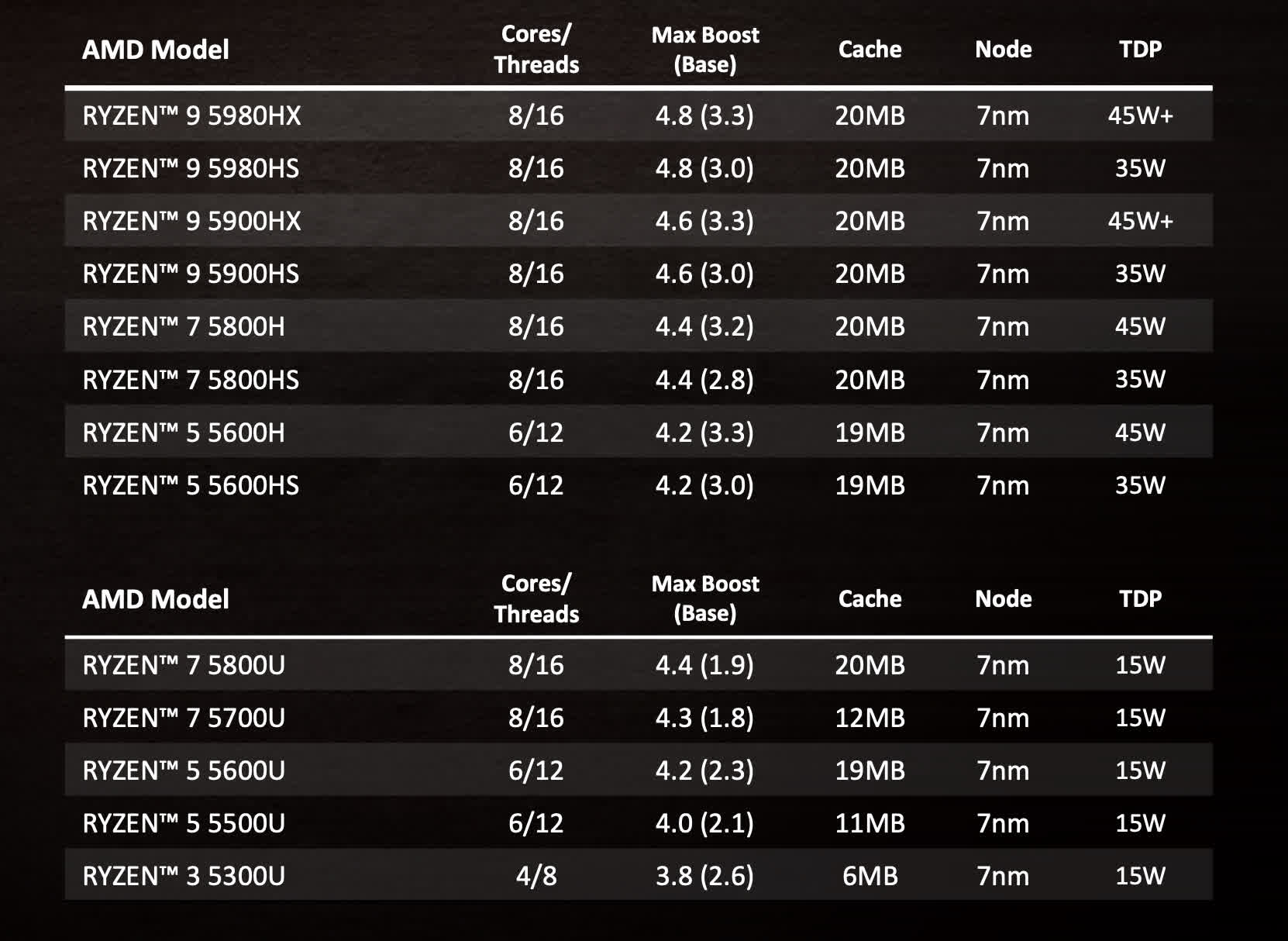
These improvements flow down to the Ryzen 5 5600U, but in a 6 core/12 thread layout. We see similar clock speed gains and same benefits from the increase to cache. What we don’t know for these parts as AMD aren’t talking design specifics yet, is whether the 5800U and 5600U feature a unified/single CCX for the CPU like on the desktop line, or whether it’s still two CCXes, although we expect a unified design.
AMD also hasn’t detailed anything to do with the GPU design and layout. The expectation here is it’s the same Vega architecture used in Ryzen Mobile 4000, with the same maximum of 8 compute units, but possibly with higher clock speeds. This is something we’ll have to explore further when AMD details the design.
As for the Lucienne parts in the Ryzen 5000 U-series, the chips built using Zen 2, AMD are essentially refreshing the best of the Ryzen 4000 line-up. The Ryzen 7 5700U is very close to what the Ryzen 7 4800U used to be, meaning it has SMT enabled with the full eight cores and sixteen threads. Previously, the 4700U had just 8 cores and 8 threads. However the 5700U isn’t quite the same as the 4800U: the new 5700U actually has a slightly higher boost clock of 4.3 GHz versus 4.2 GHz previously.
Similar for the Ryzen 5500U and Ryzen 3 5300U versus last-gen parts. The Ryzen 5 5500U is a Ryzen 5 4600U with a higher clock speed. Meanwhile the 5300U is a Ryzen 3 4300U with SMT enabled and a higher boost clock of 3.8 GHz.
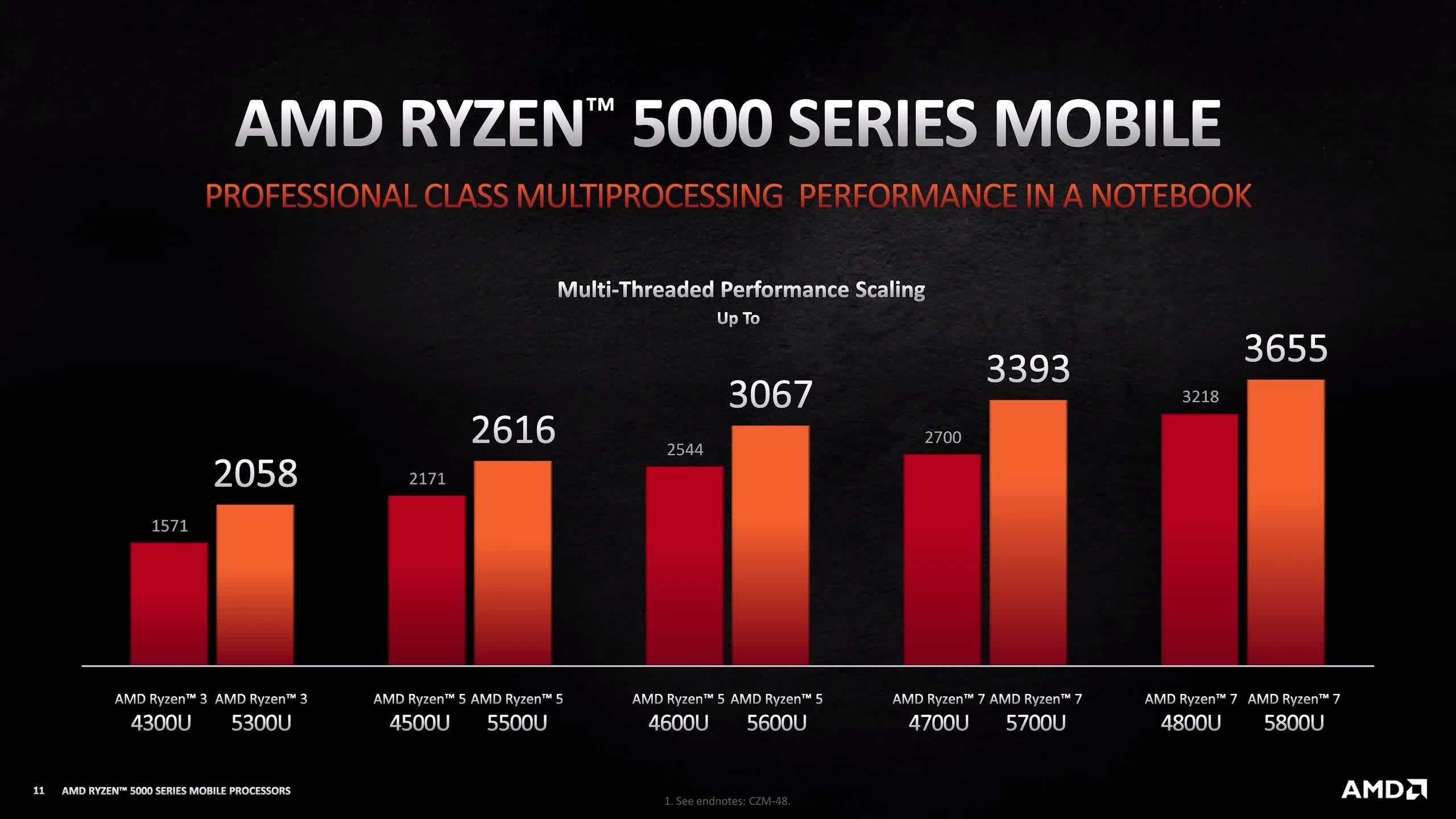
While Lucienne parts are using an older CPU architecture, the addition of SMT compared to their direct predecessors means we should be getting higher performance across the line-up, and that’s what AMD is claiming in their performance slides. These are Cinebench R20 numbers, and you can see healthy gains for multi-threading performance across the board... although these are AMD’s own numbers.
The key takeaways here are a 14% gain for the 5800U over the 4800U, a 26% gain for the 5700U over 4700U, and 21% gain for the 5600U over 4600U in Cinebench R20 multi-thread.
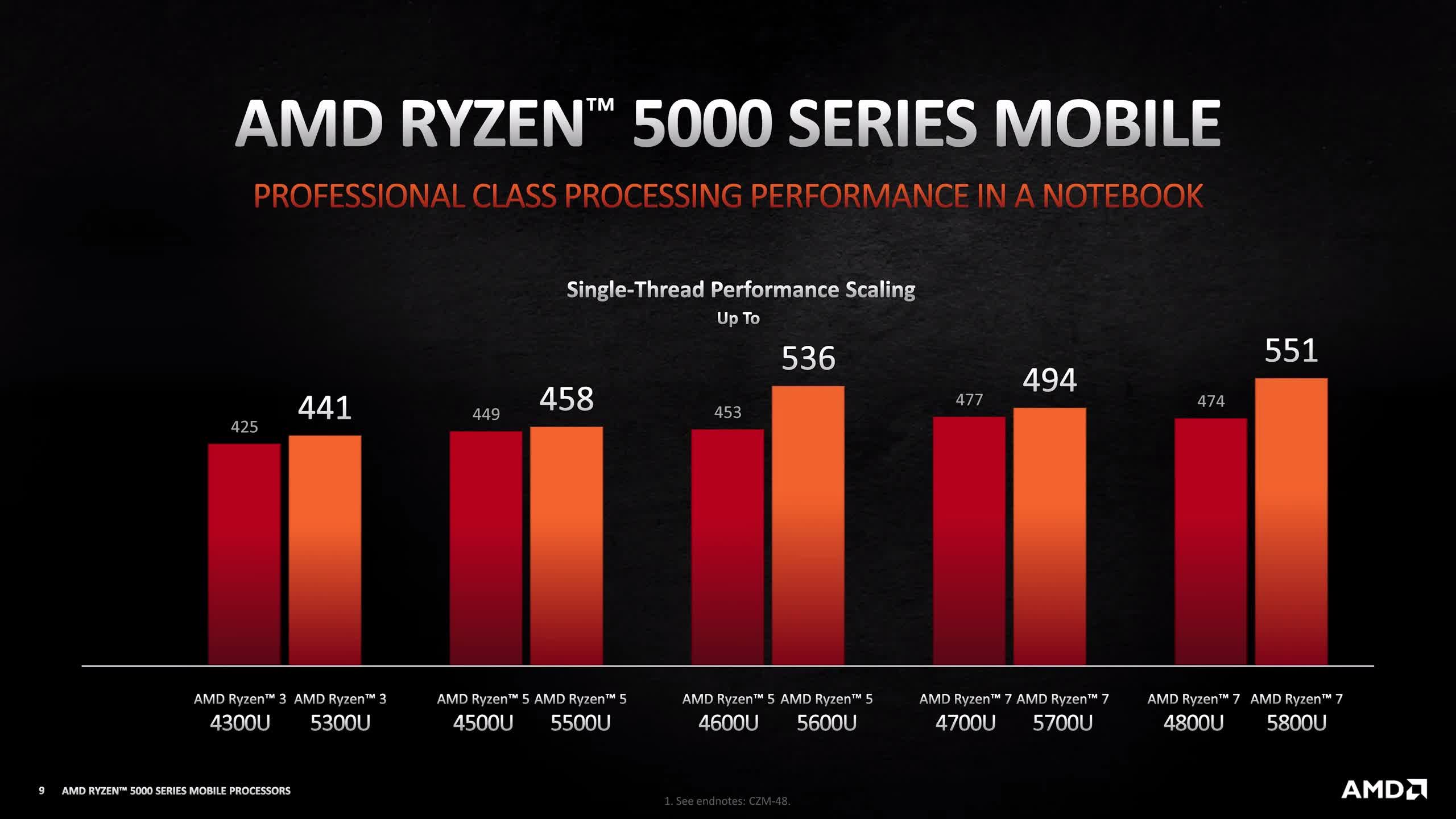
As expected the 5700U, which is very similar to the 4800U, ends up about 5% ahead in that comparison. While some numbers here like the 5800U vs 4800U don’t quite meet the full IPC gains AMD has listed previously, and that could be due to a number of factors in such a power constrained product, getting 15-20% gains from the same core count, same process node and very similar clock speeds is still quite decent.
As for single-thread performance, this is where AMD is expecting to see the biggest improvement. Again we have Cinebench R20 ST numbers here, and the two Zen 3 parts are 16 to 18 percent faster than their Zen 2 predecessors. This should significantly close the gap between Ryzen and Intel’s Tiger Lake, and we’d expect Zen 3 to comfortably beat a chip like the Core i7-1165G7 when both are configured to 15W.
For what it’s worth AMD is also claiming the best productivity performance compared to both the Ryzen 7 4800U and Core i7-1165G7 although we're not sure on the power configurations used here, so will need further testing.
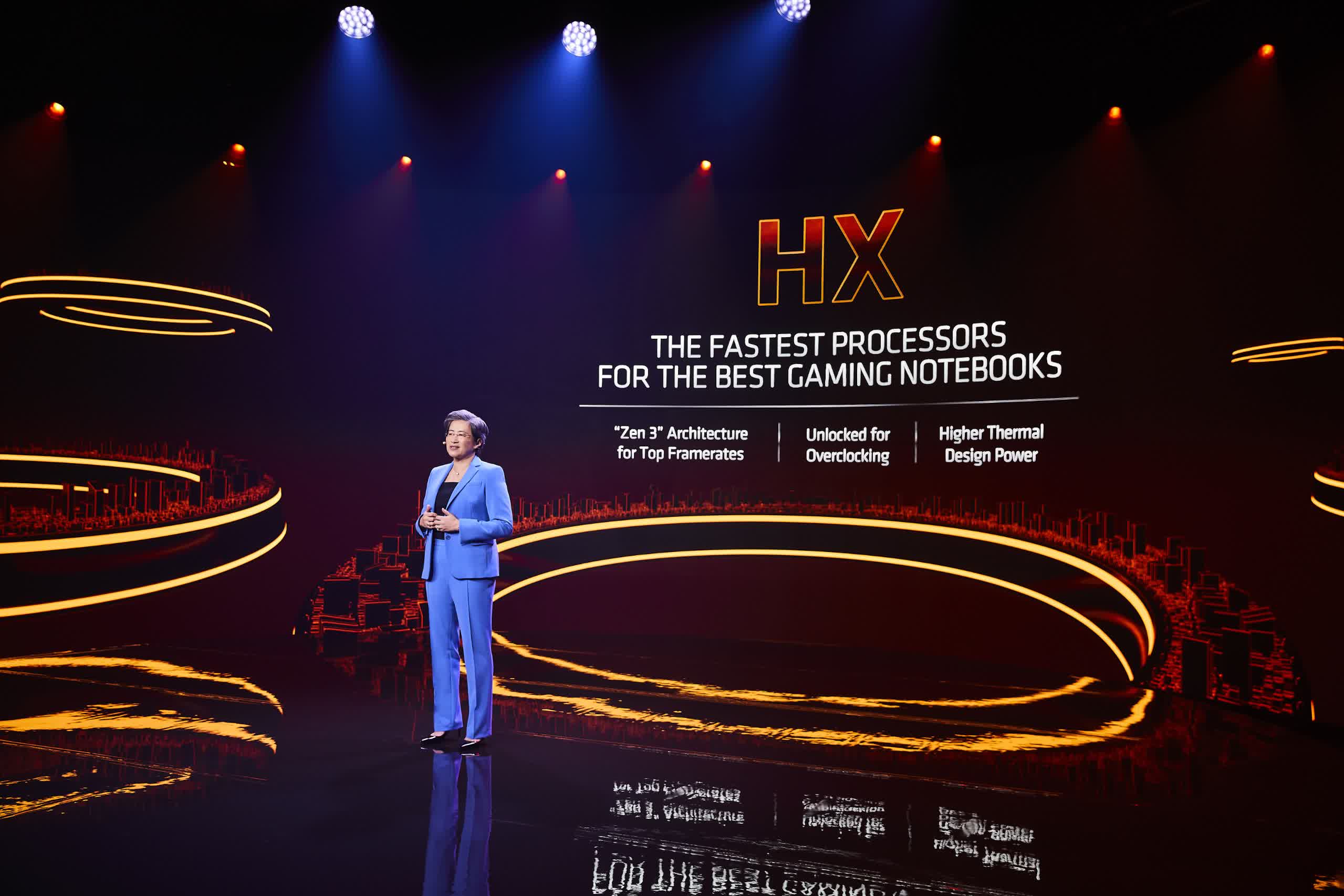
Moving to the H-series, this is where AMD is beefing up the line-up with more SKUs than ever. We have two base model H-parts at 45W: the Ryzen 7 5800H and Ryzen 5 5600H. Then we have the addition of two new “HX” CPUs at the top: the Ryzen 9 5900HX and Ryzen 9 5980HX. All of these chips have a 35W HS counterpart as well, bringing the total SKU list to 8.
All of these chips are Cezanne with Zen 3 CPU cores. There are a whopping six eight-core models, each separated by clock speeds. The 5800H starts at a 3.2 GHz base and 4.4 GHz boost. This bumps up to 3.3 GHz and 4.6 GHz for the 5900HX, and 3.3/4.8 GHz for the 5980HX. This is a hefty clock gain for the 5980HX versus AMD’s previous best Ryzen Mobile 4000 CPU, the Ryzen 9 4900H, which topped out at 4.4 GHz.
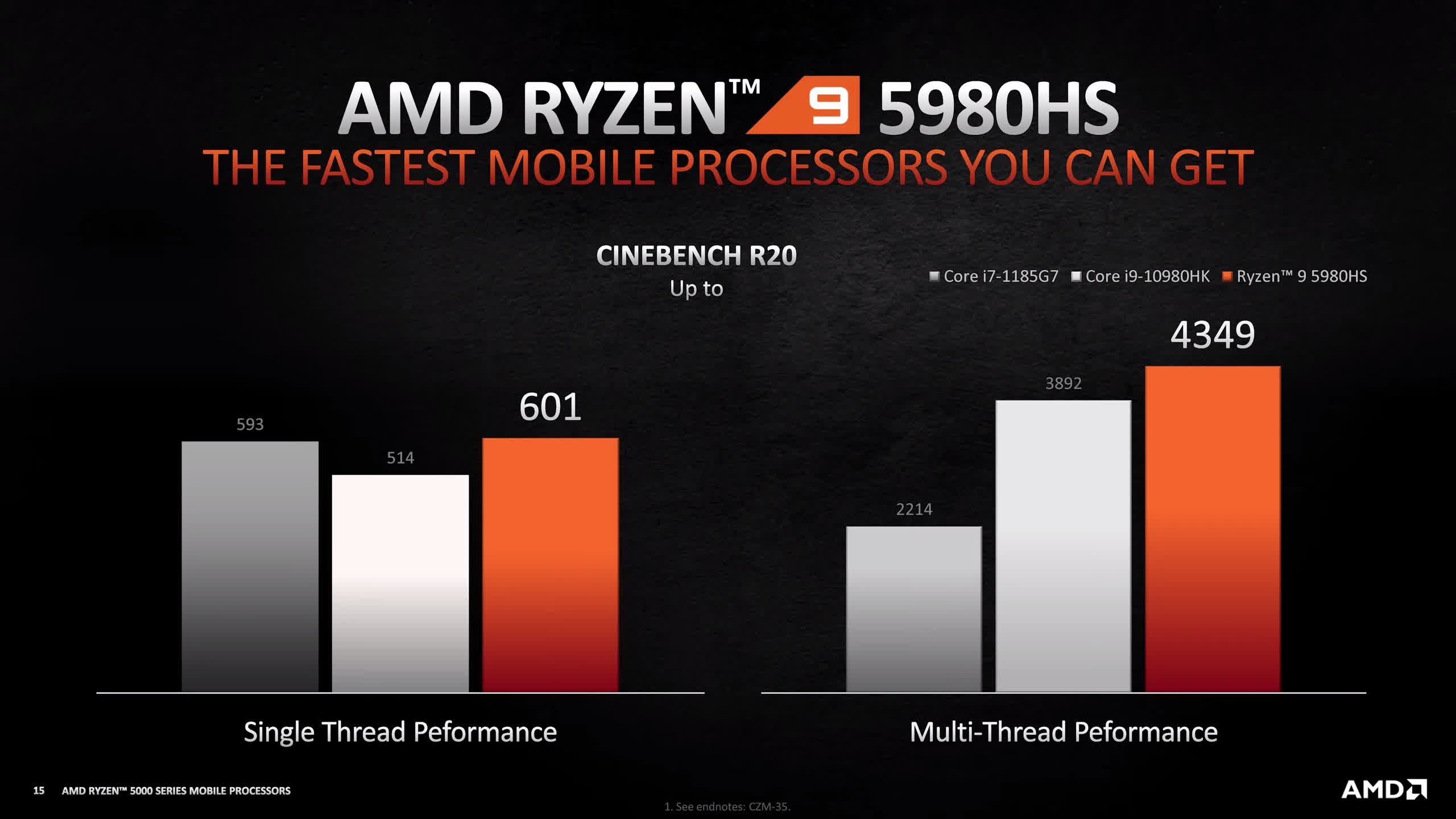
The HS-series chips are essentially better bins of the regular H or HX models, so they are listed with the same core configuration and peak clock speeds. However, to fit within the lower 35W TDP, base clocks are lower. At the lower end of the scale, the Ryzen 5 5600H offers six cores and twelve threads with clock speeds up to 4.2 GHz.
The improvements made to Ryzen 5000 versus 4000 are exactly the same as we were talking about earlier with the U-series. Zen 3 brings an IPC improvement, and peak clock speeds are anywhere from 200 to 400 MHz higher. Combined with double the L3 cache and the potential for a unified core design, these H-series chips should be much more competent at mobile gaming, where previously AMD wasn’t up to the level of Intel’s 10th-generation H-series. The fact chips can now go up to 4.8 GHz is handy in particular, in the top of the line parts.
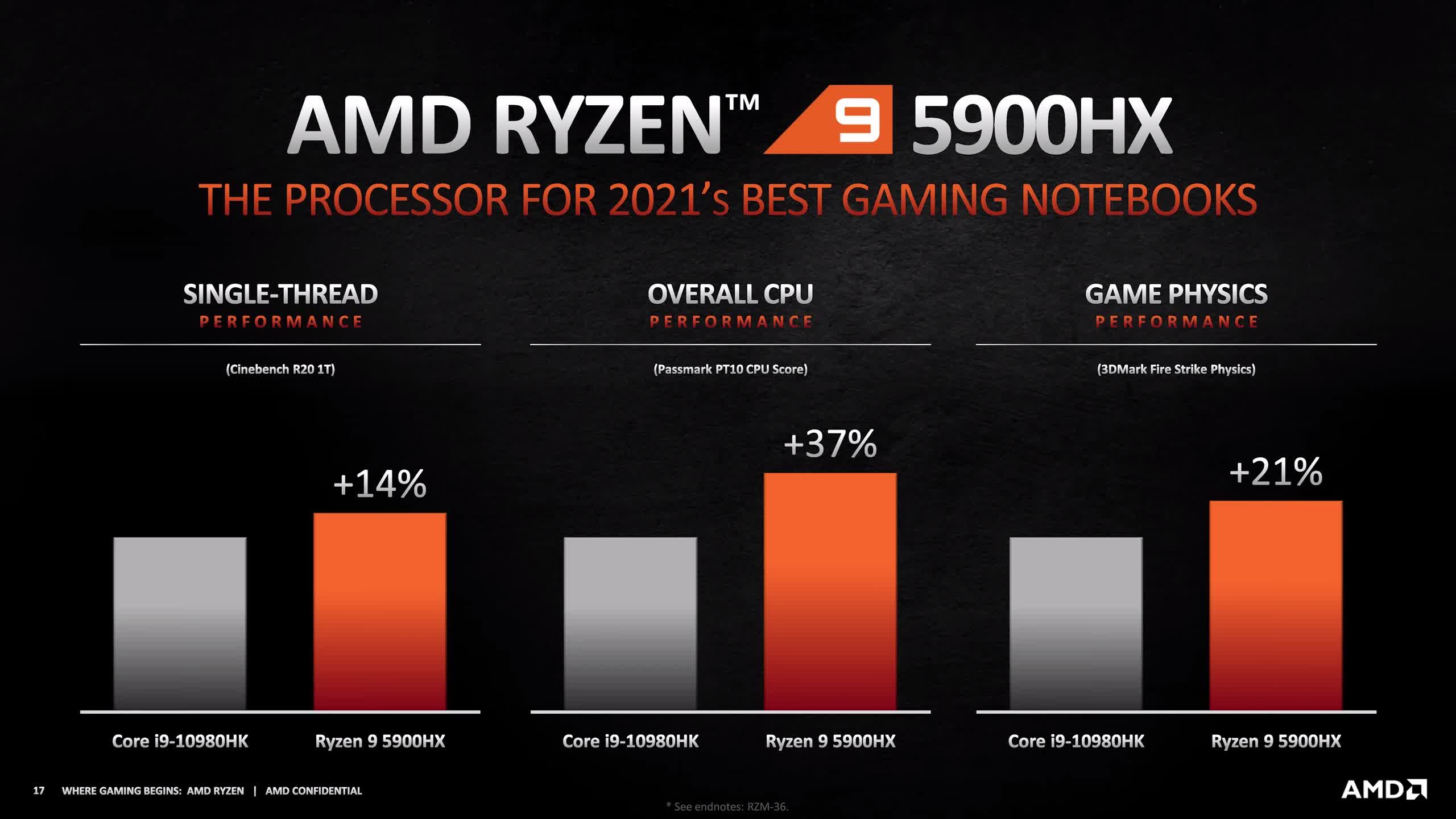
AMD did not provide as much performance data for the H-series chips. The Ryzen 9 5980HS is compared to the Core i9-10980HK and Core i7-1185G7, beating both for single and multi-thread performance. AMD is not showing a comparison to Ryzen Mobile 4000, but based on our Cinebench R20 numbers, this part would end up being about 6 percent faster in multi-thread and 22 percent faster in single-thread versus the Ryzen 9 4900HS.
We also get some data for the Ryzen 9 5900HX showing better performance than the Core i9-10980HK. This part and other HX series processors have “unleashed TDPs” and support overclocking on select OEM systems, making them even more attractive to notebook makers that often love to increase power limits for H-series chips well beyond the rated defaults.
AMD concluded by showing continued expansion of Ryzen Mobile availability, showing 150 systems coming with 5000 series chips. Certainly what we are hearing from OEMs is a much greater willingness to use Ryzen in laptops than on prior generations, and that should be reflected in many more high-end laptops – particularly gaming laptops that will pair top-end Nvidia RTX 30 GPUs with Ryzen 5000 CPUs.
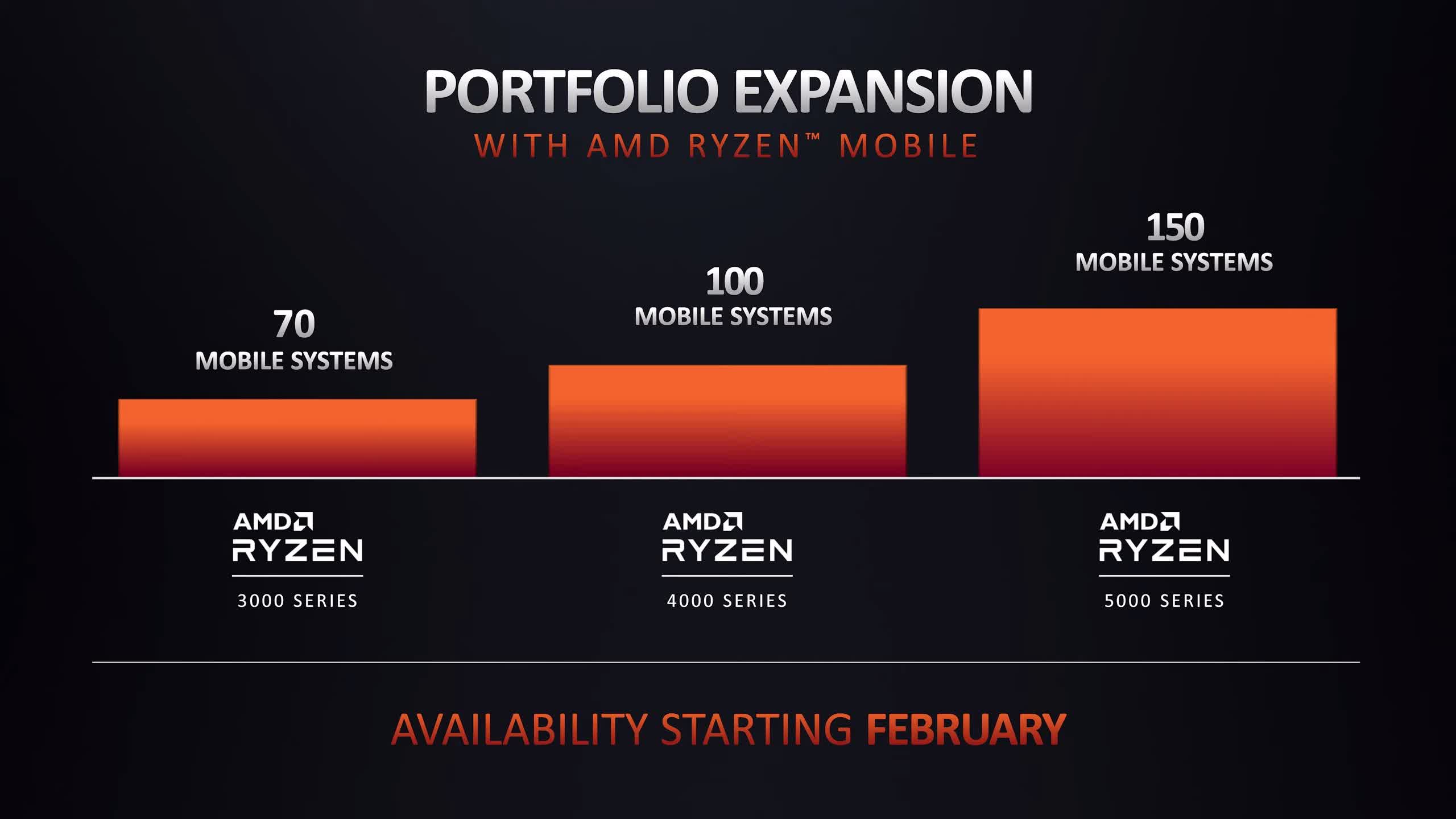
What we're not as confident in is AMD’s claim of availability starting in February. We have heard concerns from some laptop OEMs that availability for Cezanne silicon will be poor, and that may limit initial offerings. One company that we know of is only planning to release Ryzen 5000 systems paired with Nvidia’s top-end GPUs to begin with, and then work down the stack to more affordable systems as supply increases.
Availability aside, there’s a lot of promise with the new Ryzen 5000 line-up, but also a lot of questions remain. There's definitely the potential for these Zen 3 chips to do what Intel couldn’t with Tiger Lake and offer the best single-thread and best multi-thread performance in the one package. This could make Ryzen 5000 chips great buys for all sorts of laptop buyers, from those that just need something portable for basic tasks, right up to productivity beasts that want to do both content creation and gaming on their laptop. However, it will have to pass the test of our benchmarking first, and the battle between AMD and Intel for that single-thread crown looks very tight despite AMD’s gains with Zen 3.
We have yet to learn anything about the GPU layout and performance, which is an area AMD may fall behind Intel for the first time in a while.
Tiger Lake’s iGPU is very competitive, so the same Vega GPU design may not cut it here. We do know that H-series Cezanne APUs do feature higher iGPU clock speeds, potentially over 2 GHz, so let’s hope that translates to U-series as well. There are also important questions over the architecture still to be answered, like the core layout, memory compatibility, PCIe configuration and so on. Hopefully we'll be able to start benchmarking these mobile chips in the next few weeks, starting with the H-series.
AMD’s other CES 2021 announcements included the Ryzen 9 5900 and Ryzen 7 5800 as non-X, 65W variants of existing Zen 3 CPUs for the OEM market. There was also discussion on Threadripper Pro and Epyc Milan CPUs.
https://www.techspot.com/news/88262-amd-claims-fastest-mobile-cpu-title-ryzen-mobile.html